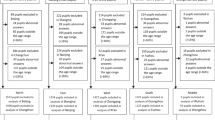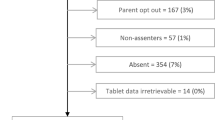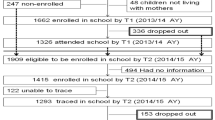Abstract
Purpose
This study aimed to determine levels of behaviour problem in primary school children, and to explore key determinants relevant to the Chinese context: being an only child, urban living, school stressors, being bullied and physical punishment.
Methods
We administered a child self-completion questionnaire to children aged 7–13 and Rutter Parent Scales to their parents in nine primary schools, in urban and rural Zhejiang Province, eastern China.
Results
Full data were available for 2,203 child–parent pairs. Rutter Scores showed that 13.2% of the children (16.4% of boys, 9.4% of girls) had a behaviour problem. Girls manifest more emotional problems (5.3 vs. 2.3%) and boys more conduct problems. Questions about school stress showed that 78% worry “a lot” about exams, 80% felt pressure to perform at school “all the time”, and 44% were bullied at least sometimes. Seventy-one percent were sometimes or often physically punished by their parents. Conduct problems were strongly significantly associated with male gender (OR 3.8 95% CI 3.0–4.6), rural residence OR 2.3, 1.3–3.4, having been bullied (1.8, 1.5–2.2) and frequent physical punishment (4.5, 3.2–5.8). Emotional problems were most strongly associated with being bullied (OR 4.9, 2.3–7.7). Being an only child was not associated with behaviour problems.
Conclusions
High levels of behaviour problems in these Chinese children could relate to high expectations in a very competitive educational environment. Our results raise concerns for the future mental well-being of those children with behaviour problems.
Similar content being viewed by others
References
Chen S, Revallion M (2004) How have the world’s poorest fared since the early 1980s? World Bank Res Obs 19(2):141–169
Hesketh T, Li L, Zhu WX (2005) The effect of China’s one child family policy after 25 years. N Engl J Med 353(11):1171–1176
Fong V (2004) Only hope: coming of age under China’s one child policy. Stanford University Press, San Francisco
Hong X (2000) Structure of child rearing values in urban China. Sociol Perspect 43(3):457–471
Chao RK (1994) Beyond parental control and authoritarian parenting styles: understanding Chinese parenting through cultural notion of training. Child Dev 65(4):1111–1119
Shen J, Yuan BJ (1999) Moral values of only and sibling children in mainland China. J Psychol 133:115–124
Jing Q, Wan C, Over R (1987) Single child family in China: psychological perspectives. Int J Psychol 22:127–138
Berndt TJ, Cheung PC, Lau S, Hu KT, Law W (1993) Perceptions of parenting in mainland China, Taiwan and Hong Kong: sex differences and societal differences. Dev Psychol 29(1):156–164
Rutter M (1967) A children’s behaviour questionnaire for completion by teachers: preliminary findings. J Child Psychol Psychiatry 8:1–11
Elander J, Rutter M (1996) An update on the status of the Rutter Parents and Teachers Scales. Child Psychol Psychiatry Rev 1(1):31–35
Verhulst FC, van der Ende J (1991) Assessment of child psychopathology: relationships between different methods, different informants and clinical judgement of severity. Acta Psychiatr Scand 84(2):155–159
Prior M, Viasinghe S, Smart D (2005) Behavioural problems in Sri lanka schoolchildren. Soc Psychiatry Psychaitr Epiemiol 40:654–662
Matsuura M, Okubo Y, Kato M, Kojima T, Takahasi R, Asai K (1989) An epidemiological investigation of emotional and behavioural problems in primary school children in Japan. Soc Psychiatry Psychaitr Epidemiol 24:17–22
Wong CK (1998) The Rutter Parent A2 Scale and the Teacher Scale B2 in Chinese II clinical validity among Chinese children. Acta Psychiatr Scand 78(1):11–17
Wong CK (1998) The Rutter Parent A2 Scale and the Teacher Scale B2 in Chinese I. translation study. Acta Psychiatr Scand 77(6):724–728
Qian Y, Wang YF (2007) Reliability and validity of behaviour rating scale of executive function parent form for school age children in China. Beijing Da Xue Xue Bao 39(3):277–283
Hesketh T, Qu JD (2005) Anxiety and depression in adolescence in urban and rural China. Psychol Rep 96:435–444
Hesketh T, Qu JD, Tomkins A (2003) Health effects of family size: cross-sectional survey in Chinese adolescents. Arch Dis Child 88:467–471
Yang B, Ollendick TH, Dong Q (1995) Only children and children with siblings in the People’s Republic of China: levels of fear, anxiety and depression. Child Dev 66:1301–1311
Liu K, Ren F, Gao XH (2002) The present condition of children’s behaviour problems in Jingzhou and analysis of correlative factors. J Health Educ China 18:345–347
Matsuura M, Okubu Y, Kojima T, Takahshi R, Wang YF, Shen YC, Lee CK (1993) A cross-national prevalence study of children with emotional and behaviour problems. A WHO Collaborative study in the Western Pacific Region. J Child Psychol Psychiatry 34(3):307–315
Wang Y, Shen Y, Gu B, Jai M, Zhang A (1989) An epidemiological study of behaviour problems in schoolchildren in urban areas of Beijing. J Child Psychol Psychiatry 30(6):907–912
Wang YF, Ren GY, Gu BM (2000) The comparative research of children’s behaviour problems in Beijing. J Mental Health China 14:51–53
Lin H, Wang YF, Wu YP (2007) A control study of a school-based life skills education on prevention of behaviour problems in third grade schoolchildren. Beijing Da Xue Xue Bao 39(3):319–322
Pharoah POD, Stevenson CJ, Cooke RW, Stevenson RC (1994) Prevalence of behaviour problems in low birthweight infants. Arch Dis Child 70:271–274
Almqvist F, Kumpulainen K, Ikaheimo K, Linna SL, Henttonen I, Huikko E (1999) Behaviour and emotional symptoms in 8 9-year-old children. Eur Child Adolesc Psychiatry 8(Suppl 4):S7–S16
Sourander A, Haavist A, Ronning JA, Multimaki P, Parkkola K, Santalahti P, Nikolakaros G, Helenius H, Moilanen I, Tamminen T, Piha J, Kumpulainen K, Almqvist F (2005) Recognition of psychiatric problems and self-perceived problems: a follow-up study from age 8 to 18. J Child Psychol Psychiatry 46(10):1124–1134
Taanila A, Ebeling H, Kotimaa A, Moilanen I, Jarvelin MR (2004) Is a large family a protective factor against behaviour and emotional problems at the age of eight years? Acta Paediatr 93(4):508–517
Jiao S, Ji G, Jing Q (1986) Comparative study of behaviour qualities of only children and sibling children. Child Dev 57:357–361
Fan F, Su L, Gill M, Birmaher B (2009) Emotional and behavioural problems of Chinese left-behind children: a preliminary study. Soc Psychiatry Psychiatr Epidemiol 45(6):655–664. doi:10.1007/s00127-009-0107-4
Hesketh T, Zhen Y, Lu L, Dong ZX, Jun YX, Xing ZW (2010) Stress and psychosomatic symptoms in Chinese school children: cross-sectional survey. Arch Dis Child 95(2):136–140
Brown PH, Park A (2002) Education and poverty in rural China. Econ Educ Rev 21:523–541
Rigby K (2003) Consequences of bullying in schools. Can J Psychiatry 48(9):583–590
Caspi A, Moffitt TE, Newmann DI, Silva PA (1996) Behaviour observation at age 13 predict adult psychiatric problems: longitudinal evidence from a birth cohort. Archives Gen Psychiatr 53:1033–1039
Kumpulainen K, Rasenen E, Henttonen I (1997) The persistence of psychiatric disturbance among children. Soc Psychiatry Psychiatr Epidemiol 32:113–122
Puura K, Almqvist F, Tamminen T, Piha J, Rasanen E, Kumpulainen K, Moilanen I, Koiviso AM (1998) Psychiatric disturbances among prepubertal children in Southern Finland. Soc Psychiatry Psychiatr Epidemiol 33:310–318
Ristkari T, Sourander A, Ronning J, Piha, Kumpulainen K, Tamminen T, Moilanen I, Almqvist F (2009) Childhood psychopathology and sense of coherence at age 18: findings from the Finnish from a boy to a man study. Soc Psychiatr Epidemiol. doi:1007/s00127-009-0032-6
Sourander A, Jensen P, Ronning JA, Niemala S, Helenius H, Sillinmaki L, Kumpulainen K, Piha J, Moilanen I, Tamminen T, Almqvist F (2007) What is the early adult outcome of boys who bully or who are bullied in childhood? The Finnish from a Boy to a Man study. Pediatrics 120(2):397–404
Liu XC, Ma DD, Kurita H (1999) Self-reported depressive symptoms among Chinese adolescents. Soc Psychiatry Psychaitr Epidemiol 34:44–47
Goodman R, Iervolino AC, Collishaw S, Pickles A, Maughan B (2007) Seemingly minor changes to a questionnaire can make a big difference to man scores; a cautionary tale. Soc Psychiatry Psychiatr Epidemiol 42:322–327
Achenbach TM (1991) Integrative guide tie the 1991 CBCL/4-18 YSR and TRF profiles. Department of Psychiatry, University of Vermont, Burlington
Kresanov K, Tuominen J, Piha J, Almqvist F (1998) Validity of child psychiatric screening methods. Eur Child Adolesc Psychiatry 7:85–95
Author information
Authors and Affiliations
Corresponding author
Rights and permissions
About this article
Cite this article
Hesketh, T., Zheng, Y., Jun, Y.X. et al. Behaviour problems in Chinese primary school children. Soc Psychiatry Psychiatr Epidemiol 46, 733–741 (2011). https://doi.org/10.1007/s00127-010-0240-0
Received:
Accepted:
Published:
Issue Date:
DOI: https://doi.org/10.1007/s00127-010-0240-0




